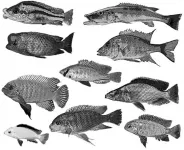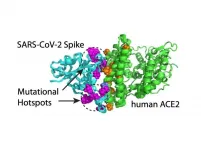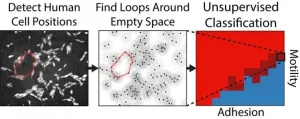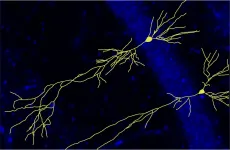(Press-News.org) Computed tomography -- CT scanning -- which combines a series of X-ray images taken from different angles around an organism and uses computer processing to create cross-sectional images of its bones, is providing new insight into an old initiative to characterize fishes in Africa's Lake Malawi.
The process, demonstrated in a new study using the high-resolution X-ray computer system in Penn State's Center for Quantitative X-Ray Imaging, is important because it will lead to the identification and management of more of the fish species in Africa's second largest lake, according to lead researcher Jay Stauffer Jr., distinguished professor of ichthyology in the College of Agricultural Sciences.
"Before they can effectively manage fish populations, they have to know what is there," he said.
Regarded by scientists as the most vibrant and diverse body of water in the world, Lake Malawi is home to between 800 and 1,000 species of colorful fish called cichlids; however, the lake is overfished by humans for food. As a result, about 10% of those species are believed to be endangered.
Located between Malawi, Tanzania and Mozambique, Lake Malawi is immense. It covers an area of more than 11,000 square miles and holds 7% of the world's available surface freshwater -- by comparison, appreciably more than Lake Erie.
"About half the species in the lake still haven't been described," said Stauffer, who has characterized, or discovered, more than 60 cichlid species himself. Since 1983, he has visited Lake Malawi for extended periods annually, collecting cichlid specimens while scuba diving.
After preservation, those specimens have been housed in the Penn State Fish Museum at Rock Springs, and approximately 35,000 are scheduled to be transferred to the National Research Institute of South Africa this year after COVID-19 restrictions are lifted. In the recent study, Stauffer and colleagues performed CT scans on selected specimens in the collection.
The entire head of each fish was scanned, and the researchers focused on the "morphology" -- analyzing the shape and profiles of the skulls and the structure and arrangement of teeth on the pharyngeal jaws and the oral jaws. This helps to determine a species' specialization to capitalize on certain food sources and to compete with other species.
"We chose species to scan that we knew had different feeding repertoires, and then we wanted to compare their head morphology with their species' feeding specializations to determine the relationships between morphology and behaviors," Stauffer said. "The purpose of this research was to show how observed behavioral traits of shallow-water species can be linked with morphological attributes using data collected from selected cichlids. Such associations can be used to predict behavior of deep-water or rare species, based on head morphology."
In findings recently published in Ecology and Evolution, the researchers reported that high-resolution CT scanning will enable scientists to infer life history and behavioral characteristics of rare or extinct fishes from a detailed examination of morphology and linkages between morphology and behavior observed in surviving species.
Stauffer and other scientists will use CT scanning as they continue to identify cichlids in Lake Malawi. The technology is nondestructive, he explained, so they can collect data from specimens in museum collections.
"High-resolution computed tomography permits us to view the internal morphology and examine areas that would otherwise be destroyed by dissection," he said. "It will be a great help to me because I'm going over there and spending four to six weeks a year at the institute, identifying fishes that are in its museum."
Many of those older museum specimens are surprising him, noted Stauffer, who is 70 and has no plans to retire. "I'm finding a lot of species I've never seen before in more than 30 years of diving in Malawi. I think they're probably extinct. I'd like to describe these species, and the CT scans will help me to make accurate guesses about what their behavior was in the lake."
Adrianus Konings, ichthyologist, photographer, and founder and publisher of Cichlid Press in El Paso, Texas; and Joshua Wisor, doctoral degree student in wildlife and fisheries science, contributed to this research.
INFORMATION:
Funding for the study was provided in part by the National Science Foundation/National Institutes of Health joint program in ecology of infectious diseases and the Pennsylvania Agricultural Experiment Station, Penn State.
"I think you're on mute." This was the most-used phrase of 2020, according to Human Resources Online. Emblazoned on T-shirts and embossed on coffee-mugs, we used the meme to make fun of ourselves while learning video-conferencing tools like Zoom and Microsoft's Teams.
But for the more than 7 million Americans who suffer from vocal disorders, not being heard is a serious matter. Many people who have normal speaking skills have great difficulty communicating when their voice box, the larynx, fails. This can occur if the vocal cords, the two bands of smooth muscle tissue in the larynx, suffer damage from an accident, surgical procedure, viral infection or cancer.
There is no replacement for the ...
SARS-CoV-2 has evolved to acquire mutations on the spike protein--the part of the virus that protrudes from its surface and latches onto cells to infect them--that enhance the coronavirus' ability to bind to human cells or evade antibodies. A new study from the Centers for Genomics and Systems Biology at New York University and NYU Abu Dhabi uses computational modeling to assess the biological significance of spike protein mutations, uncovering versions of the virus that bind more tightly or resist antibodies and offering a promising public health surveillance tool.
The study, which appears in the Journal of Molecular Biology, also suggests that these mutations on the spike protein are a key ...
Press release - ESE statement: COVID-19 and endocrine and metabolic diseases. An updated statement from the European Society of Endocrinology
New expert statement confirms strong links between our hormones and COVID-19
The endocrine system is strongly involved in SARS-Cov-2 infection - so much so that evidence of an "endocrine phenotype" of COVID-19 has emerged, according to a statement by the European Society of Endocrinology (ESE) published in the journal Endocrine in April 2021. Leading endocrinology researchers looked into the evidence that has accumulated over the past year since the pandemic emerged, and consistently found evidence ...
PROVIDENCE, R.I. [Brown University] -- The field of mathematical topology is often described in terms of donuts and pretzels.
To most of us, the two differ in the way they taste or in their compatibility with morning coffee. But to a topologist, the only difference between the two is that one has a single hole and the other has three. There's no way to stretch or contort a donut to make it look like a pretzel -- at least not without ripping it or pasting different parts together, both of which are verboten in topology. The different number of holes make two shapes that are fundamentally, inexorably different.
In recent years, researchers have drawn on mathematical topology to help explain a range of phenomena like phase transitions in matter, aspects of Earth's climate and even how zebrafish ...
One-quarter to one-third of young, active patients who undergo anterior cruciate ligament reconstruction experience a second ACL injury after they return to sport (RTS). New research indicates that young athletes who feel confident about their knee health at the time of medical clearance for sports participation after ACL surgery have a higher likelihood of meeting all RTS criteria related to physical function but also have a higher likelihood of experiencing a second ACL injury within 2 years after RTS.
The study, which included 159 participants with an average age of 17 years, is published in the Journal of Orthopaedic Research.
"These data suggest that as health care providers, we may need to re-evaluate the tools we currently use to determine readiness to return ...
The rhythmic motions of hair-like cilia move liquids around cells or propel the cells themselves. In nature, cilia flap independently, and mimicking these movements with artificial materials requires complex mechanisms. Now, researchers reporting in ACS Applied Materials & Interfaces have made artificial cilia that move in a wave-like fashion when a rotating magnetic field is applied, making them suitable for versatile, climbing soft robots and microfluidic devices. Watch a video of the artificial cilia here.
Replicating movements found in nature -- for example, the small, whip-like movements of cilia -- could ...
While the APP protein is well-known for its key role in Alzheimer's disease, its contribution to healthy brain function, by contrast, has remained largely unknown until now. Recently, an international research team, led by molecular biologist Prof. Dr Ulrike Müller from Heidelberg University, gained new insights on the physiological functions of the APP protein family by using a mouse model lacking APP. The absence of APP during brain development was shown to result in the malformation of important brain regions implicated in learning and memory. Consequently, these mice were severely impaired in their learning abilities and exhibited autistic-like ...
In an article published in the International Journal of Mental Health Nursing, experts stress that the COVID-19 pandemic presents the "perfect storm" for family violence, where a set of rare circumstances have combined to aggravate intimate partner violence, domestic abuse, domestic violence, and child abuse.
Factors during the pandemic that have come together to contribute to family violence may include increased stress and trauma, economic hardship, imposed isolation, and decreased access to community and faith-based support.
The authors note that public health officials and mental health professionals need to be aware of the impact of disasters on family violence, and they should strive to identify those at risk and provide ...
Individuals are often prescribed increasing numbers of medications as they age, and while many of these prescriptions are justifiable, some may be inappropriate. A recent analysis published in the British Journal of Clinical Pharmacology examined the results of all studies investigating associations between potentially inappropriate prescribing--which includes prescribing medications that may not produce benefits relative to harm and not prescribing medications that are recommended--and outcomes of older adults.
Potentially inappropriate prescribing was significantly associated with a range of health-related and system-related outcomes, including functional decline, falls, ...
By the end of the first year of the pandemic in metropolitan Stockholm, investigators estimate that one-fifth of adults in the region previously had COVID-19. The findings, which are published in the Journal of Internal Medicine, come from analyses of anti-viral antibody responses in healthy blood donors and pregnant women.
For the study, researchers examined blood from 2,600 blood donors and 2,500 pregnant women taken between March 14th 2020 and February 28th 2021. Blood donors and pregnant women had a similar rate of past infection, approaching 19% of the study group by the end of February 2021, shortly ...




